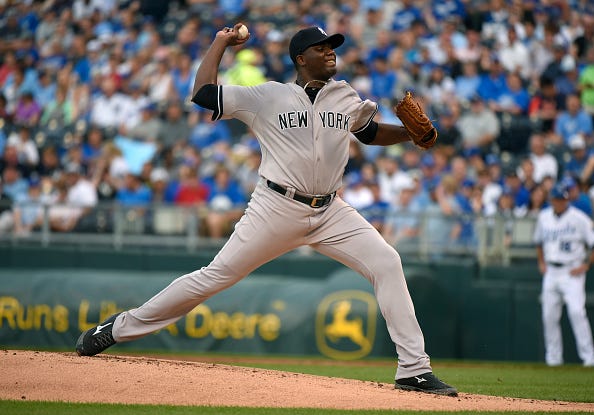What Pineda Needs to Improve

Michael Pineda's May 10th performance against the Orioles was historically good. His sixteen strikeouts were the most by any pitcher since David Wells fanned that many on July 30, 1997, and he became only the fourth Yankees pitcher to rack up that many K's in a game, joining Wells, David Cone, and, of course, Ron Guidry. Pineda's outing was also notable for its brevity. Including Pineda's, only seven starts in baseball history have been made in which the pitcher lasted seven innings or fewer and struck out 16 batters or more. This puts Pineda in pretty good company: three of them were made by Randy Johnson (all in 2001), two by Jake Peavy, and one by Cliff Lee.
Yet, he followed up his best game of the season with his worst as a Yankee. By the metric of game score, Pineda's 5.1-inning, 10-hit, 5-run appearance against the Royals was the second-worst start by a Yankees pitcher this season, worse than Nathan Eovaldi's clunker against the Nationals on Tuesday and only ahead of CC Sabathia's 5-inning, 7-run shellacking against the Mets on April 25. Add up Pineda's 16 K's against the Orioles and his 1 K against the Royals and he still falls short of Guidry's 18 on June 17, 1978. What exactly was wrong with Pineda? It's true that the Royals may sport baseball's third best offense by runs scored and second best by wOBA and wRC+, but Pineda was definitely off his game in substantive ways. While Pineda’s fastball—which has so much action on it that it’s simply called a cutter by PITCHf/x tracking website BrooksBaseball.com—averaged a mile per hour faster against the Royals than it had for his starts up to that point—93.3 MPH vs. 92.2 MPH, respectively—it didn’t quite have the same movement. Its horizontal movement was about 0.47 inches, versus 0.63 for the season, and its vertical movement was also 0.3 inches less. Usually, batters muster a 19.3% line drive rate against this pitch, but last Friday they smacked a line drive on 54.6% of balls put in play. Pineda often likes to use his slider in two-strike counts, throwing it nearly 50% of the time in that situation, but the slider didn’t have the same bite. It usually gets 4.4 inches of horizontal movement, but that was down a whopping 1.5 inches to 2.9. This is one of Big Mike’s go-to pitches with two strikes, and he usually gets a whiff on 31.1% of swings against it with two strikes on the batter. However, this lack of movement hurt the righty last Friday, as he only managed to get 8.3% of batters to swing and miss on the pitch with two strikes, partially explaining his lack of strikeouts. Pineda’s location was also off, as he was leaving balls up in the zone more often and wasn’t getting them down low quite as much as he has throughout the season. The Royals aren’t known for their longball power, as they rank 26th in baseball in home runs. They are, however, second in the league in hits, doubles, and triples, and consequently are second in team slugging percentage. While they didn’t hit any home runs against Pineda on May 15th, they didn’t just hit them where they ain’t—they hit the ball hard. Because of Pineda’s reduced command and movement, and because of their prowess at the plate, the Royals’ batted ball velocity averaged 90 MPH against Pineda, which is up 4 MPH, as prior to that game batters had hit the ball with an average exit velocity of 86 MPH against Pineda. Harder-hit balls make it more difficult for the Yankees defense to field groundballs, which is especially of importance for Pineda, given his 52.7% groundball rate this season. In order to return to form, Pineda will have to improve his command over his last outing and get the bite on his cutter and slider that has made those pitches so potent this season. He’ll have an easier time doing it today against the Rangers, whose below-average offense ranks 21st in baseball by wRC+ this season.


